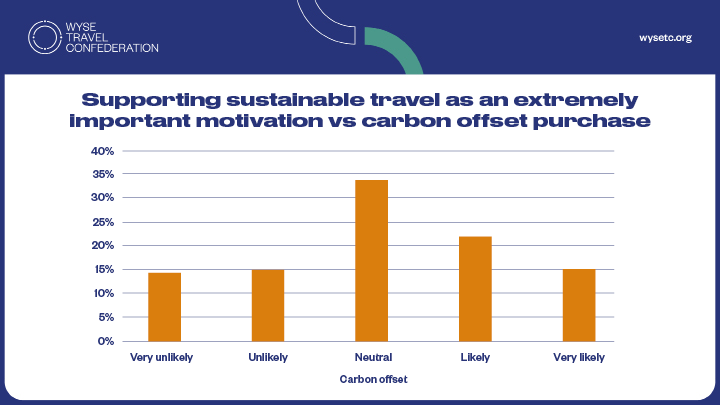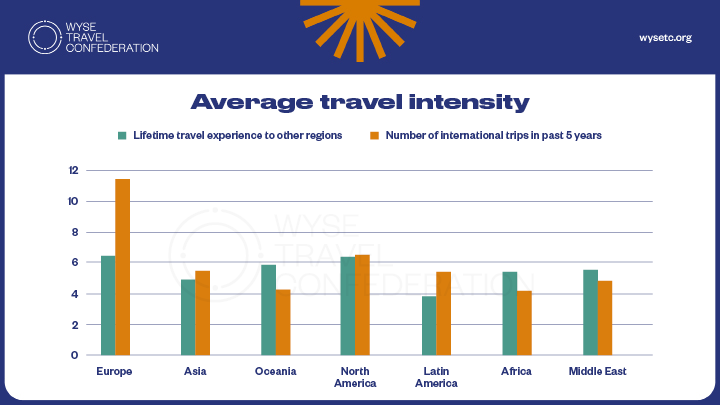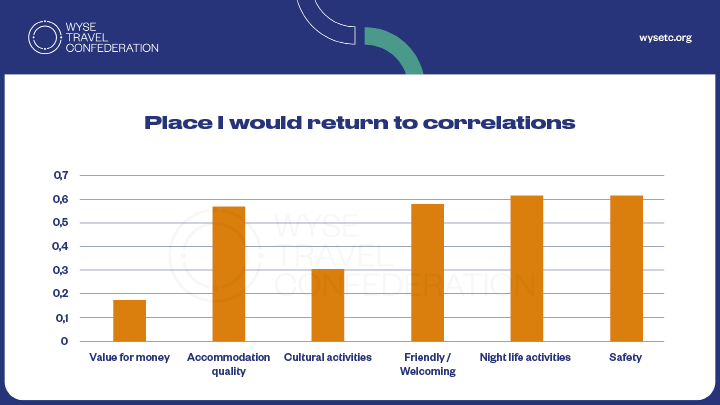What will define youth travel in the near future?
Based on what we hear on the ground and what we see in the data, here are four things that we think the youth travel industry can act on in 2024.
1. Closing the ‘think-do’ gap on sustainability
There’s been a lot of talk about how important the environment, sustainability and climate change are for millennials and gen z. That’s great, but there’s perhaps been a little too much faith placed on the ability of these generations to drive big change. Change involves awareness and action. People are now talking about how to close the think vs do gap that exists around sustainability for all travellers.
In our New Horizons 5 survey of international youth travellers, just 15% of young travellers who think it is extremely important to support sustainable travel initiatives told us they would also be very likely to buy a carbon offset.

Maybe it’s just carbon offsets nobody wants to pay for? It could be. Perhaps young travellers are just not convinced that carbon offsets are a good means of supporting sustainable travel. But what is?
There is a similar, although slightly more positive picture regarding eco-friendly and fair trade products. Between 22 and 24 percent of young travellers who think it is extremely important to support sustainable travel said they would be very likely to buy eco-friendly (24%) or fair trade (22%) products while travelling.
Change comes from thinking plus doing. Next steps for the youth travel industry? Evolve the choice for young travellers. Eliminate the think-do gap. Make it a given that a choice to travel is a responsible and sustainable one. For package providers, include the carbon offset and work with a trusted professional to educate your clients on why it matters. For hostels and hotels, direct guests to fair trade goods and services in the destination or bring those goods and services into the property. Work with partners who understand the youth market and are aligned with the Sustainable Development Goals (SDGs) or other operational frameworks to close the gaps together, in a complementary way. Hint, these partners come to WYSTC – see you there?
2. Information is everywhere
New Horizons has been tracking the number of information sources that young travellers use to plan and book international trips since 2002. Each edition of the survey has seen a jump in the number of sources used and we wonder just how much more information can people actually absorb. Well, it looks like young people have not reined it in for 2023.
The number of information sources used by young travellers to plan and book an international trip has climbed steeply since 2012, with an average of over 8 different sources in 2023.


Perhaps this speaks to the increasing consolidation of Online Travel Agents (OTAs) and their quickly earned prowess in offering consumers just about everything for a trip, end-to-end. The amount of information and level of detail available to consumers is vast. Information is well organised by OTAs and metasearch platforms for search. What is not searchable may just find its way to you via social media micro-influencers and algorithms.
Where does it go from here? Good question. Has anyone asked ChatGPT?
Information is everywhere – for everyone – and it will continue to be used by consumers (and the parents of young consumers) to carefully scrutinise what brands say they offer. Alongside of that, there is growing awareness about algorithms, filter bubbles, cookies and AI. There are also signs that policymakers and big tech companies are taking steps regarding transparency and accountability. A lot remains to be seen.
3. Opening access to international travel
Who has access to international travel? Are inequalities of travel access all down to funds? The COVID-19 pandemic perhaps raised awareness about who can travel where in the world and for what reason. The ‘how’ of pandemic travel arguably brought some attention to visas and other administrative procedures of international travel.
Young people hold a lot of travel potential over the course of their lives, yet access to international travel is not equal in all world regions. This is evident even from a survey of those who have in fact travelled internationally. It’s likely that a different and likely more dramatic picture would present itself if we were not focused solely on international travellers.
Europe is a world region of young travellers with a high level of travel intensity in the past five years and in terms of lifetime travel experience. This may suggest a high level of “revenge travel” in post-COVID Europe. However, looking across all world regions, young people who have travelled internationally seem to have a similar level of travel experience. Latin America is the world region of young travellers with the lowest level of lifetime travel experience. Oceania and Africa have the lowest levels of travel intensity in the past five years.

What can be done to increase access to international experiences for young people that might not see it as a realistic option? What are the benefits of encouraging international travel? What are the consequences of not encouraging it?
Young travellers are motivated to travel with positive impact and help people in the destination. Perhaps the youth travel industry can devise ways to channel the privilege, motivation and funding of some travellers towards helping other travellers gain access to first international experiences. A sort of paying it forward kind of thing. We know you’re good at this stuff!
4. Destinations – why return or go somewhere else?
Before the COVID-19 pandemic there was a fair amount of discussion in European cities regarding ‘over-tourism’. Some cities began moving away from traditional destination promotion and more towards destination management. What drives destination appeal in the international youth travel market? If strong appeal has the potential to drive repeat visitation, is that necessarily a good thing?
While some destinations might be re-thinking the value of strong appeal or repeat visitation, what can we learn about repeat visitation in order to inform strategies for less-visited destinations? Given young travellers have a lifetime of travel opportunities ahead of them, what drives re-visitation for them?
We asked young travellers to rate cities they have ever visited – a total of 69 cities worldwide were rated by young travellers responding to the New Horizons survey. Factors such as accommodation quality, cultural activities, nightlife, safety, friendliness and overall value for money were rated. We also asked the traveller to rate the city in terms of it being ‘a place to return to’.
We found that overall, a city’s nightlife and safety are strongly connected to a city being considered a place to return to by young travellers. How young travellers perceive the city’s level of friendliness is also important to it being a place worth returning to.

The correlation between perceived value for money and place to return was low for major global cities like New York, London and Paris. However, each of these major cities has their own unique factor most strongly impacting its status as a place to return to. Bucking the trend, value for money does actually feed into young travellers’ perceptions of Paris as a place to return to. In New York, friendliness is most strongly associated with it being a place to return to. And cultural activities are most important for London’s reputation as a place for young travellers to return to.
Young travellers are open to new experiences. They’ve also indicated that they’re looking for more affordable destinations in order to keep travelling in the face of rising costs for basic living expenses. There are also young people in the world who haven’t travelled much or far yet. For destinations looking to attract new travellers, perhaps cultivating nightlife, safety and friendliness will put your city on the youth travel map of places to return to.
What’s on your radar for youth and student travel in 2024? Let us know!
